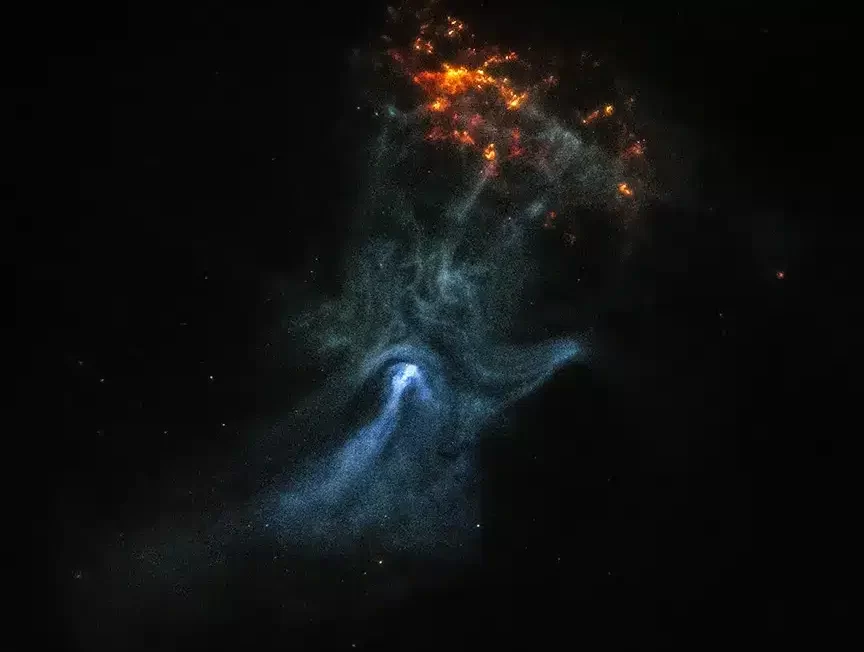NASA’s X-Ray Telescopes Unveil Ghostly Bones Of ‘Cosmic Hand’

NASA’s two advanced X-ray space telescopes are highlighting an astonishing image just in time for Halloween: the “bones” of a hand-shaped structure reaching out in the vast expanse of space. This celestial formation originates from the remnants of a collapsed star, spewing out plumes of energized matter and antimatter.
The findings are likened by NASA researchers to the very origins of X-rays, which date back to 1895 and German physicist William Röntgen. While experimenting with cathode rays using a Crookes tube (an early experimental electrical discharge tube), he noticed a fluorescent glow in a nearby chemically coated screen. The tube was surrounded by black cardboard, which should have prevented any light from escaping, yet the screen still glowed. Röntgen soon discovered that this new type of ray could penetrate through most substances, including human tissue, but left bones and metals visible. Recognizing the potential of his discovery, he took an X-ray photograph (or radiograph) of his wife Anna’s hand, clearly showing her bones and her wedding ring. Because he didn’t know the nature of these rays, he named them “X-rays,” with “X” representing the unknown.
So where did this cosmic “hand” come from?
About 1,500 years ago, a colossal star in our galaxy consumed all its nuclear fuel. This event led the star to collapse into itself, resulting in the formation of a neutron star. These types of stars, especially the rotating ones with powerful magnetic fields known as pulsars, are akin to cosmic laboratories. They exhibit extreme physical phenomena that can’t be duplicated here on Earth.
One of the most intriguing manifestations of young pulsars is the “pulsar wind nebula,” a spectacle formed by the rapid jets of matter and antimatter propelled away from the pulsar.
Almost 20 years ago, NASA’s Chandra X-ray Observatory first spotted the pulsar PSR B1509-58. It revealed a pulsar wind nebula looking strikingly like a human hand, which was aptly named MSH 15-52. Situated 16,000 light-years from our planet, the pulsar can be found at the “palm” of this cosmic hand.
NASA’s newest X-ray telescope, the Imaging X-ray Polarimetry Explorer (IXPE), recently spent 17 days observing this celestial marvel. “The IXPE data gives us the first map of the magnetic field in the ‘hand,’” says Roger Romani of Stanford University, who spearheaded the research, in a statement. “The charged particles producing the X-rays travel along the magnetic field, determining the basic shape of the nebula, much like bones shape our hand.”
This latest data from IXPE shed light on the phenomenon of X-ray polarization. This process provides details about the orientation of X-rays, which is influenced by the magnetic field of the source. In numerous areas of MSH 15-52, the polarization is astoundingly high, suggesting a very straight and steady magnetic field. This means there’s minimal turbulence in these parts of the pulsar wind nebula.
Josephine Wong, a co-author from Stanford, drew a parallel to medical science after the findings. “We’re all familiar with X-rays as a diagnostic medical tool for humans. Here we’re using X-rays in a different way, but they are again revealing information that is otherwise hidden from us,” she says.
One standout feature of MSH 15-52 is a radiant X-ray jet stretching from the pulsar to the “wrist” of the hand-shaped structure. The IXPE data exposed the intricacies of this jet. At its inception, the polarization is minimal, indicating a turbulent area with entangled magnetic fields. However, as you move further along the jet, the magnetic field lines straighten, leading to increased polarization.
These observations suggest that particles receive an energy boost in the tumultuous regions near the pulsar (located at the palm’s base) and then flow to areas where the magnetic field is consistent, such as the wrist and fingers.
“We’ve uncovered the life history of super energetic matter and antimatter particles around the pulsar,” says Niccolò Di Lalla, another co-author from Stanford. “This teaches us about how pulsars can act as particle accelerators.”
Furthermore, IXPE has identified similar magnetic patterns in other pulsar wind nebulae, hinting at a commonality among these cosmic entities.
The findings are now available in The Astrophysical Journal.
